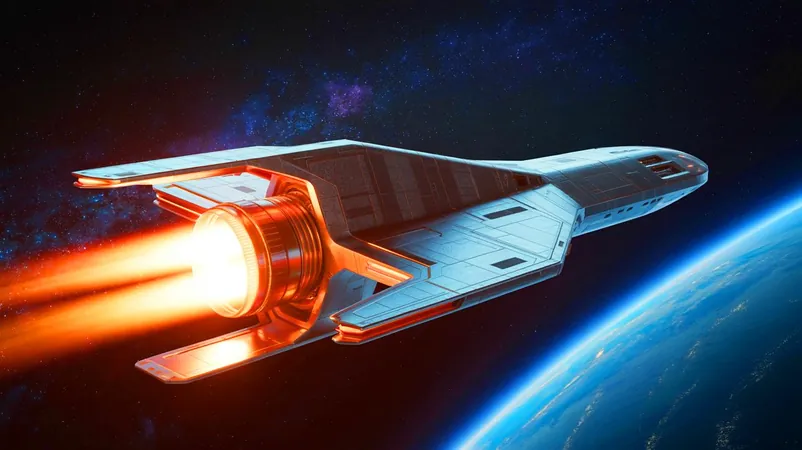
Revolutionary Liquid Uranium Rocket Could Slash Mars Travel Time to Just 6 Months!
2025-09-14
Author: William
A Quantum Leap in Space Travel
In an extraordinary breakthrough for space exploration, scientists at The Ohio State University are pioneering a game-changing propulsion system that could redefine our journey to Mars and beyond. Enter the centrifugal nuclear thermal rocket (CNTR), an innovative technology designed to enhance rocket performance while drastically minimizing risks associated with engine operations.
Fast-Tracking Our Galactic Dreams
Unlike traditional chemical rockets that burn through vast amounts of fuel with frustratingly low efficiency, the CNTR system leverages liquid uranium to heat propellant directly, promising to double the performance of conventional nuclear engines. As the quest to explore the solar system heats up, this innovation could pave the way for groundbreaking human missions to distant celestial bodies.
Time Is of the Essence!
The slow pace of chemical propulsion has long posed challenges for long-distance space missions. For instance, the New Horizons probe took nearly a decade to reach Pluto. The CNTR, boasting a jaw-dropping specific impulse of 1,800 seconds, can cut travel times dramatically, offering the tantalizing possibility of a Mars mission within just 420 days. This contrasts sharply with chemical engines that achieve around 450 seconds.
A Bold Vision for the Future
Spencer Christian, a PhD student spearheading CNTR’s prototype development, envisions a direct six-month journey to Mars. This unprecedented reduction in travel time not only opens new exploratory horizons but also lessens health risks tied to long-duration space travel. Moreover, the CNTR could accelerate science missions to the outer planets and even Kuiper Belt objects!
Engineering Challenges Ahead
While CNTR technology holds immense promise, it comes with its own set of engineering obstacles. Key challenges include ensuring stable startup and operation while minimizing uranium fuel loss during engine shutdowns. Dean Wang, who leads the CNTR project, remains optimistic about overcoming these hurdles in the next five years.
Adaptability and Future Missions
One of the most intriguing features of CNTR is its versatility. The system can use various propellants—ranging from ammonia to methane—to optimize missions based on available resources, potentially enabling a sustainable human presence in space. This flexibility could even facilitate ambitious one-way robotic missions to distant planets like Saturn and Neptune.
United for Exploration: NASA and Ohio State Team Up
The vision for CNTR is supported by a NASA grant, underscoring its significance in advancing nuclear propulsion technology. This collaboration between academia and governmental agencies symbolizes a national commitment to overcoming deep-space exploration challenges, positioning the U.S. at the forefront of the next wave of cosmic discovery.
Unlocking New Territories in the Cosmos
CNTR technology doesn’t just aim to benefit national interests; it could also accelerate our progress in understanding and discovering the furthest reaches of our solar system. By cutting down on travel times and increasing payload capacities, this propulsion system could make previously impractical missions a reality.
A Transformative Impulse for Humanity
The implications of CNTR technology extend far beyond technical advancements. With quicker and more efficient travel, we could embark on missions that expand our knowledge of the universe and even lay foundations for permanent bases on other planets. This marks a monumental leap toward humanity’s goal of becoming a multi-planetary species.
The Journey Ahead
As The Ohio State University pushes the boundaries of propulsion technology, we stand on the cusp of a new era in space exploration. With continued innovation, the future of humanity in space may be faster, safer, and more accessible than we ever imagined. How will these advancements shape our exploratory pursuits? The expedition to discover this answer promises to be just as thrilling as the cosmic frontiers we aim to conquer!









 Brasil (PT)
Brasil (PT)
 Canada (EN)
Canada (EN)
 Chile (ES)
Chile (ES)
 Česko (CS)
Česko (CS)
 대한민국 (KO)
대한민국 (KO)
 España (ES)
España (ES)
 France (FR)
France (FR)
 Hong Kong (EN)
Hong Kong (EN)
 Italia (IT)
Italia (IT)
 日本 (JA)
日本 (JA)
 Magyarország (HU)
Magyarország (HU)
 Norge (NO)
Norge (NO)
 Polska (PL)
Polska (PL)
 Schweiz (DE)
Schweiz (DE)
 Singapore (EN)
Singapore (EN)
 Sverige (SV)
Sverige (SV)
 Suomi (FI)
Suomi (FI)
 Türkiye (TR)
Türkiye (TR)
 الإمارات العربية المتحدة (AR)
الإمارات العربية المتحدة (AR)